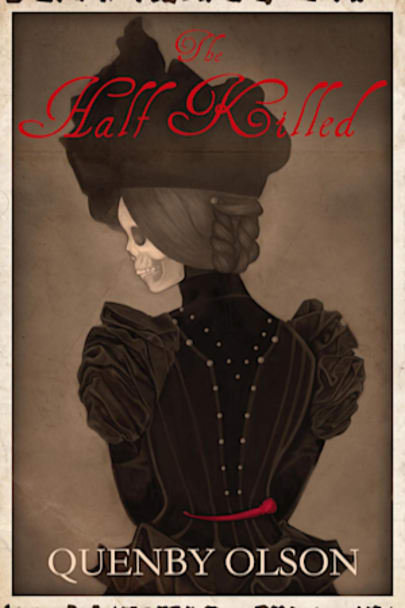Dorothea Hawes has no wish to renew contact with what lies beyond the veil. After an attempt to take her own life, she has retired into seclusion, but as the wounds on her body heal, she is drawn back into a world she wants nothing more than to avoid.She is sought out by Julian Chissick, a former man of God who wants her help in discovering who is behind the gruesome murder of a young woman. But … woman. But the manner of death is all too familiar to Dorothea, and she begins to fear that something even more terrible is about to unleash itself on London.
And so Dorothea risks her life and her sanity in order to save people who are oblivious to the threat that hovers over them. It is a task that forces her into a confrontation with her own lurid past, and tests her ability to shape events frighteningly beyond her control.
more



I’ve had The Half Killed on my shelf for a while now, because it sounded so fascinating; I was responsibly saving it up as a treat for after I’d accomplished a few other goals. Naturally, I read it almost all in one go.
This book is unique. I feel like that word might be too open to interpretation, so I’ll add that it’s unique in a very good way that nonetheless makes you feel slightly off-balance. The opening chapter was done in second-person POV, which I wasn’t sure I liked at first. But almost the entire rest of the book is in first-person POV, which made it stand out in such a way that it’s clear it was an authorial choice. I could be completely wrong, but I now suspect that the opening chapter might have actually been from the villain’s perspective, or else used as a method of setting the reader’s initial unease. Either way, while I wasn’t sure I liked the initial chapter, I appreciated it more and more as the book went on.
The Half Killed is full of this unsettling feeling, in more ways than one. It’s got a fantastically gritty, creepy vibe to it that makes full use of the dirtiness and desperation of the era. And every once in a while, it makes you miss a step, because you’re expecting something that doesn’t come. Because The Half Killed could easily seem like it’s a murder mystery, a thriller, a fantasy, or any number of other things. But by the end, I decided that it was actually a novel of internal horror, akin in some respects to the Penny Dreadful television series. A body drops within the first little bit, but the investigation is more of a vehicle for the reader to uncover the main character’s past than it is a whodunnit. The focus is on the growing sense of fear and dread, and the main character’s struggles to force herself forward, in spite of those things. This, dear readers, is a gorgeous sort of narrative horror walking simulator, where the story unfolds for you as you go. We’re not here to mash buttons–we’re here to enjoy the view.
I should add that The Half Killed is the sort of subtle metaphysical horror that even a wimp like me can enjoy. The prose is lyrical and gorgeous, so that you’re so wrapped up in the beauty of it that you sometimes forget to be scared. And in spite of the horror, it is ultimately a story with a certain amount of hope and self-determination, which I deeply appreciate. The main character’s struggles are something of a parallel for people with chronic conditions, who experience many of the same symptoms and desperate feelings of helplessness and are often not fully believed. I’m sure this is part of what resonated with me specifically, and it’s worth going into the book being aware of that parallelism.
All in all, I feel like The Half Killed does not fit very well into any specific genre conventions. But for me, at least, that is part of its beauty. And I would heartily recommend it for anyone who enjoys dark, flowing prose the same way that I do.
I loved everything about this book!